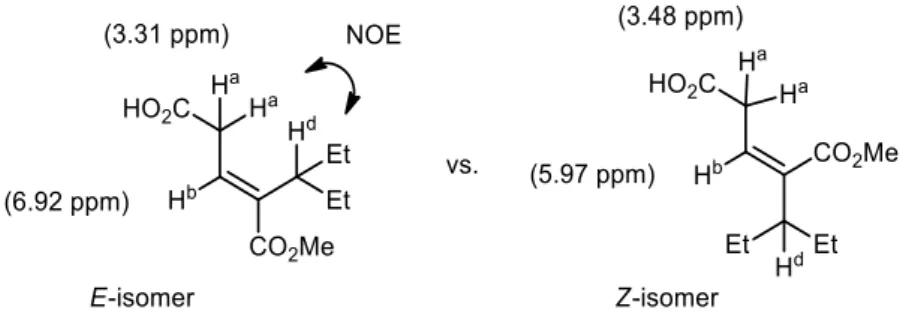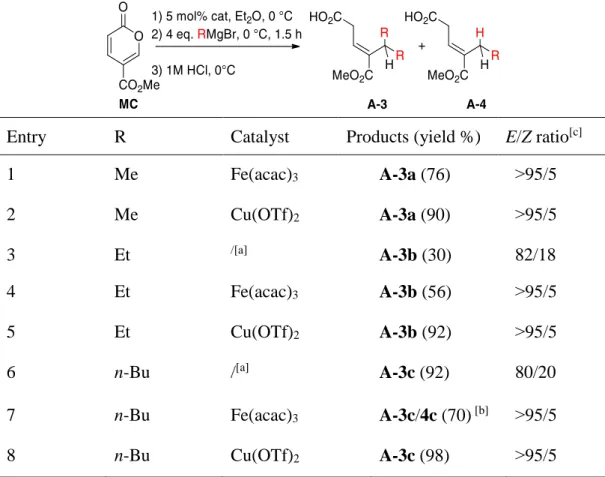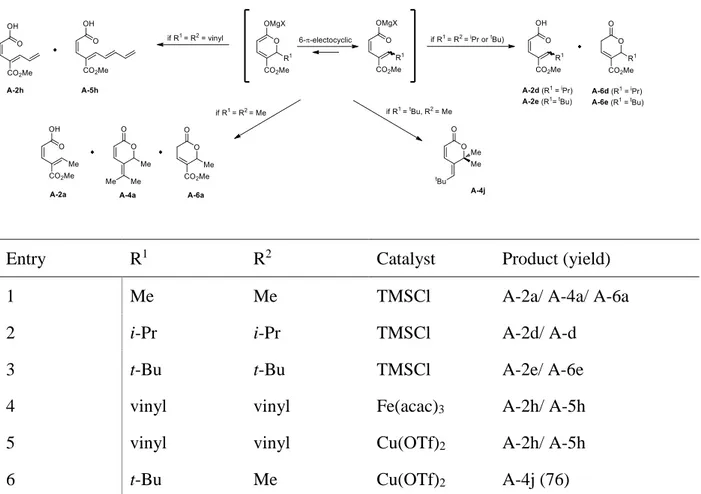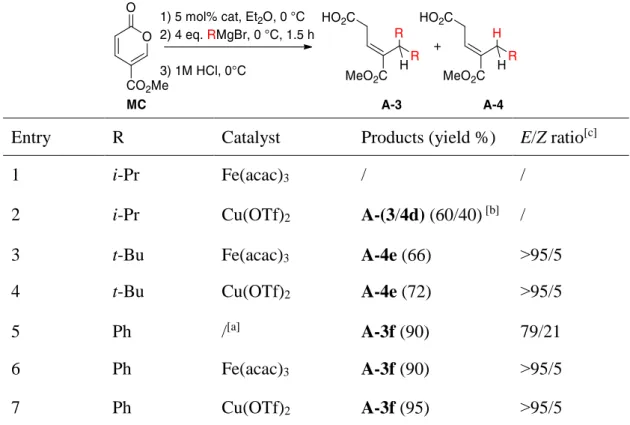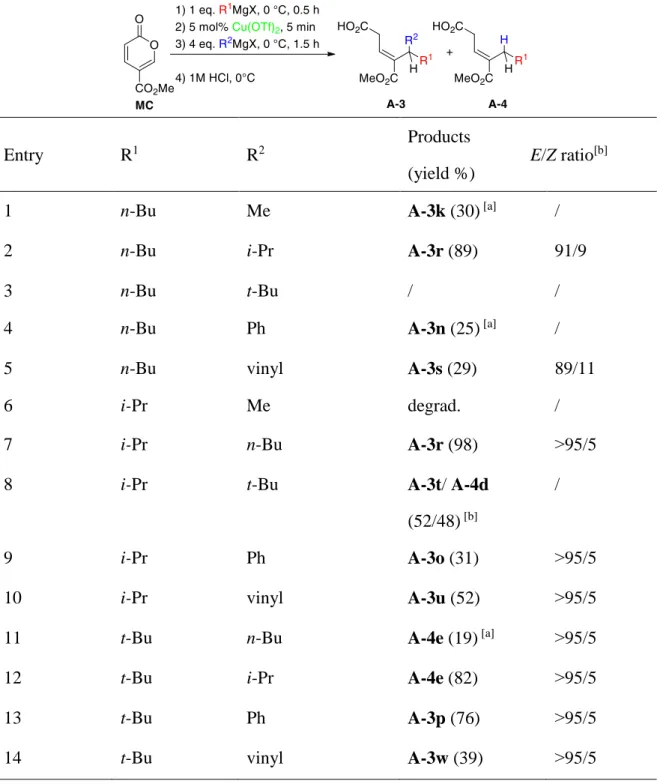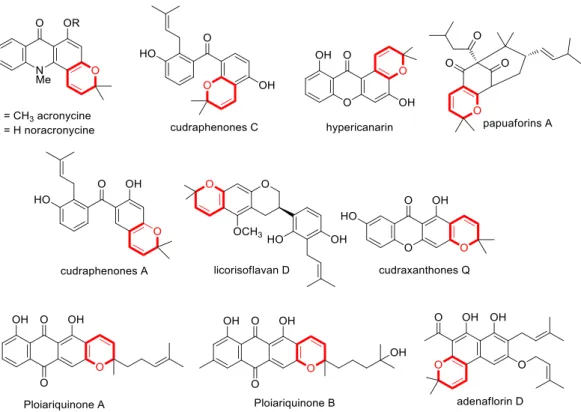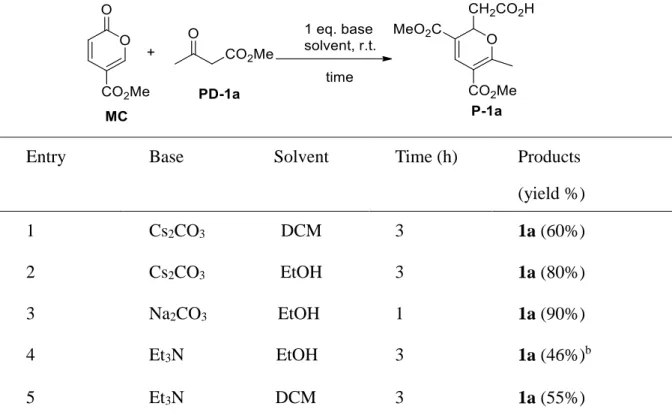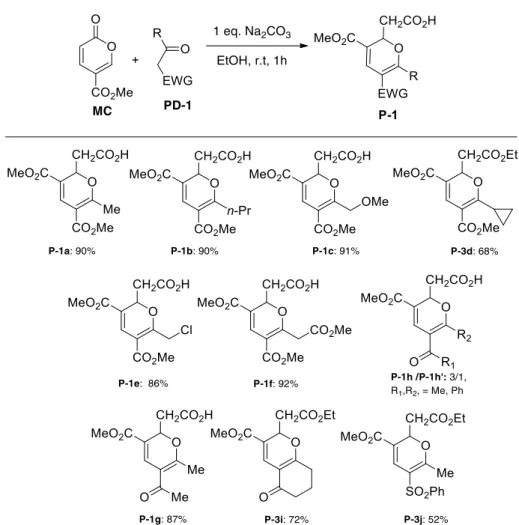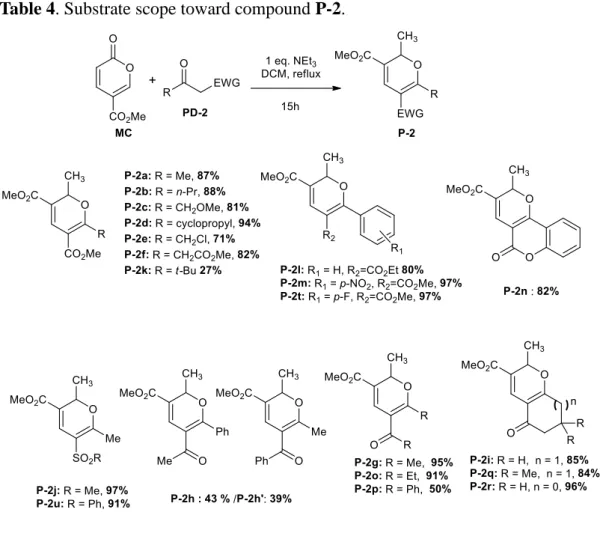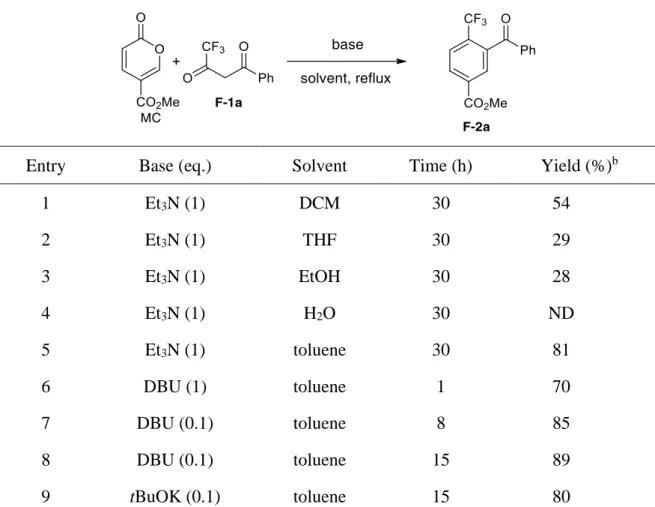HAL Id: tel-02922317
https://tel.archives-ouvertes.fr/tel-02922317
Submitted on 26 Aug 2020HAL is a multi-disciplinary open access archive for the deposit and dissemination of sci-entific research documents, whether they are pub-lished or not. The documents may come from teaching and research institutions in France or abroad, or from public or private research centers.
L’archive ouverte pluridisciplinaire HAL, est destinée au dépôt et à la diffusion de documents scientifiques de niveau recherche, publiés ou non, émanant des établissements d’enseignement et de recherche français ou étrangers, des laboratoires publics ou privés.
efficient Preparations of Unsaturated Carboxylic Acids,
2HPyrans, Trifluoromethyl Benzenes and Fluorescents
Molecules
Liang Chang
To cite this version:
Liang Chang. Sustainable Transformations of Methyl Coumalate : efficient Preparations of Unsatu-rated Carboxylic Acids, 2HPyrans, Trifluoromethyl Benzenes and Fluorescents Molecules. Organic chemistry. Sorbonne Université, 2018. English. �NNT : 2018SORUS109�. �tel-02922317�
Sorbonne Université
Chimie Moléculaire de Paris-Centre
Institut Parisien de Chimie Moléculaire / Chemical Biology
Sustainable Transformations of Methyl
Coumalate: Efficient Preparations of Unsaturated
Carboxylic Acids, 2HPyrans, Trifluoromethyl
Benzenes and Fluorescent Molecules
Par Liang CHANG
Thèse de doctorat de Chimie Organique
Dirigée par Pr. Serge THORIMBERT et Dr. Luc DECHOUX
Présentée et soutenue publiquement le 19 Juillet 2018 Devant un jury composé de :
Pr. Sylvie CONDON Professeur Rapporteur
Dr. Xavier MOREAU Maître de conférences Rapporteur Pr. Sandrine BOUQUILLON Professeur Examinatrice Dr. Cyril OLLIVIER Directeur de Recherche Examinateur Pr. Serge THORIMBERT Professeur Directeur de thèse Dr. Luc DECHOUX Maître de conférences Directeur de thèse
To learn without thinking is blindness, to think without learning is idleness.
<Analects>
子曰:学而不思则罔, 思而不学则殆。
i
Acknowledgments
I am grateful to my supervisor Pr. Serge Thorimbert for giving me the opportunity to study in this group. I would like to thank him for his generous help, excellent chemical education and for his trust in me and my project, as well as for his new ideas for my chemistry. I will always remember his dedication and patience. I am thankful to Dr. Luc Dechoux for being my co-supervisor. I want to thank him for many useful discussions, valuable ideas and particularly appreciated the freedom he gave me. I am very happy to work with these two gifted scientists. I would like to thank my PhD jury members; Pr. Sylvie Condon, Pr. Sandrine Bouquillon, Dr. Xavier Moreau, Dr. Cyril Ollivier who devoted their precious time reviewing my thesis and providing valuable suggestions.
Special thanks to my thesis monitoring committee members Pr. Marine Desage-El Murr, Dr. Mansour Haddad, Dr. Yongmin Zhang.
I would like to thank Dr. Michèle Salmain, Dr. Nathalie Fischer-Durand, and Anthony for helping me with the fluorescence experiments.
I would express my gratitude to my proofreaders: Dr. Vincent Corcé, Dr. Benoît Bertrand.
In this group, I had the chance to collaborate with many smart and friendly students and researchers, Kévin, Lucrèce, Amara, Kristina, Nikolay, Jérémy, Robin, Pokai I would thank them for their support and accompany and I acknowledge Pr. Jaouen, Dr. Vessieres, Dr. Top, Dr. Botuha, Dr. Pigeon, Mr. Martial.
The IPCM has a fabulous infrastructure and engineer team for research, I would like to thank Omar and Cédric for HR-Mass-Service, Geoffroy for X-ray diffraction and the NMR team.
I want to offer my special thanks to my friends, life in Paris was enjoyable when they were around, Xiguang&Lin, Yong&Xue, Wenjing, Sha, Xiaolei, Lu, Bo, Shaoping, Zhijie&Jingjing, Xiang, Nailiang, Hongxi, Shuaiyuan, Fei, Jun, Yan,
ii
Jiang.
I would like to sincerely extend my deepest gratitude to my parents and my parents in law, their unconditional support and love that I will be forever grateful.
iii
Table of Contents
Acknowledgments ... i
Abstract ... vii
List of Abbreviations... ix
Chapter 1 Introduction:Methyl Coumalate ... 1
1.1 Introduction ... 3
1.2 Preparation of Methyl Coumalate ... 4
1.3 MC involved [4+2] Diels-Alder reaction ... 5
1.3.1 MC as dienes in Diels-Alder reactions ... 6
1.3.2. MC as Dienes to form Aromatics ... 9
1.3.3 MC as dienophile in Diels-Alder reactions ... 19
1.4. MC participates in [2+2] cycloadditions ... 20
1.5. MC reacts with 1,3 dipoles... 22
1.6. Preparation of pyridin-2(1H)-one from MC ... 24
1.7. MC participates in [6+4] cycloaddition ... 27
1.8. MC via 1,6 Michael addition reactions ... 27
1.9. References ... 30
Chapter 2: β,γ -Unsaturated carboxylic acids by one-pot sequential
double 1,6- addition of Grignard reagents onto methyl coumalate. ... 35
2.1. Introduction ... 37
2.2. One-pot sequential double 1,6- addition of one same Grignard reagent ... 40
2.3. One-pot sequential double 1,6- addition of two different Grignard reagents... 44
2.4 The studies on other substituted α-pyrone substrates ... 48
2.5. Proposed mechanism for stereoselective 1,6-double addition ... 49
2.6. Conclusions ... 50
2.7. Experimental Section ... 50
2.8. References ... 59
Chapter 3. Preparation of Substituted 2H-Pyrans via a Cascade
Reaction from Methyl Coumalate and Activated Methylene
Nucleophiles. ... 63
iv
3.1. Introduction of the project ... 65
3.2. Optimization of the reaction conditions for 2Hpyran synthesis ... 69
3.3. Substrate scope for preparation of 2H-pyran ... 71
3.4. Proposed unified mechanism ... 73
3.5. Conclusion ... 75
3.6. Experimental section ... 75
3.7. References ... 88
Chapter 4. A solvent-free, base-catalyzed domino reaction towards
trifluoro methylated benzenes from bio-based methyl coumalate ... 91
4.1. Introduction ... 93
4.1.1. Cycloaddition towards trifluoromethylated benzenes ... 94
4.1.2. The synthesis of aromatics via a 6π-electrocyclic ring closure process ... 97
4.1.3. Our hypothesis from MC to CF3 benzene ... 98
4.2. Optimization of the Reaction Conditions ... 99
4.3. Application to a variety of trifluoromethyl benzenes ... 102
4.3.1 Gram scale synthesis of F-2b ... 105
4.4. Plausible mechanism for the cascade reaction leading to trifluoromethyl benzenes . 106 4.6. Experimental section ... 107
4.7. Notes and references ... 123
Chapter 5. Bio-based methyl coumalate involved
Morita-Baylis-Hillman reaction ... 129
5.1. General introduction of Morita-Baylis-Hillman reaction ... 131
5.2. Methyl coumalate involved MBH reaction ... 133
5.2.1.Optimization of reaction condition ... 133
5.2.2. Synthesis of bio-based MBH adducts ... 136
5.2.3. Plausible mechanism for the novel MBH reaction ... 138
5.2.4. Synthesis of diphenylmethanol derivative from MBH adduct ... 139
5.3. The regioselective transformation of MBH adducts ... 140
5.3.1 General introduction... 140
5.3.2. The study of regioselective substitution ... 142
v
5.3.4. The transformation to hydroisobenzofuran and hydroisoindole cores ... 148
5.4 Asymmetric Morita-Baylis-Hillman reaction with MC ... 149
5.4.1 Bibliographic introduction ... 149
5.4.2. MC involved Asymmetric Morita-Baylis-Hillman reaction ... 151
5.5. Conclusion ... 156
5.6. Experimental section ... 157
5.7. References ... 169
Chapter 6. A solvent-free, catalyst-free Michael addition
dearomatization strategy: A sustainable protocol towards novel
fluorescent dyes... 173
6.1. General introduction ... 175
6.2. Self promoted Michael addition dearomatization protocol ... 178
6.3. Plausible mechanism for the dearomatization ... 181
6.4. Photophysical properties of D-2j and its application for protein labelling ... 182
6.5. Conclusion ... 186
6.6. Experimental part ... 186
6.7 References ... 198
vii
Abstract
The idea of producing new chemicals from renewable feedstocks has become of great interest in the field of synthetic chemistry and creates many potential opportunities for molecules based on renewable carbon sources. A main challenge lying ahead in the development synthesis from biorenewable feedstock is to generate such structural diversity in an efficient manner. Therefore, intensive synthetical studies on renewable chemicals by different method are required. In this dissertation, our investigations are based on, but not only limited to sustainable synthesis from bio-based methyl coumalate, also involves other research fields, which includ electrocyclic reactions, conjugate addition of Grignard reagents, organocatalysis (Baylis-Hillman reaction) and dearomatization reactions.
Chapter 1 gives a review about the preparation and applications of methyl coumalate.
Chapter 2 discribes an efficient regio- and stereo-selective metal-catalyzed addition of two Grignard reagents. This synthetic approach opens an access to a wide variety of functionalized β, γ-unsaturated carboxylic acids in a modular way. Chapter 3 explores reactions of methyl coumalate with a wide range of methylene active compounds such as keto-esters or keto-sulfones and cyclic or acyclic diketones afforded more than thirty 2,3,5,6-tetrasubstituted 2H-pyrans.
Chapter 4 reports a novel, efficient, and environmentally compatible method for CF3-substituted benzene production which employs tBuOK as a catalyst, and is
solvent-free.
Chapter 5 introduces an efficient C-C bond formation between the bio-based methyl coumalate and a variety of imines and aldehydes via Morita-Baylis-Hillman type process.
viii
with an unprecedented pyrido[1, 2-a] fused heterocyclic scope, which can tolerate eleven types of aza-aromatics.
ix
List of Abbreviations
Ac: acetyl MBH: Morita-Baylis-Hillman
Ar: aryl MC: methyl coumalate
br: broad Me: methyl
Bu: butyl NMR: nuclear magnetic resonance
d: doublet o: ortho
DBU: 1,8-Diazabicycloundec-7-ene OTf: Trifluoromethanesulfonate DBN: 1,5-Diazabicyclo(4.3.0)non-5-ene p: para
DCM: dichloromethane Ph: phenyl DMAP: dimethylaminopyridine Pr: propyl
DMF: dimethylformamide PTC: phase-transfer catalyst DMSO: dimethylsulfoxide q: quartet
EDG: electron-donating group r.t. : room temperature ee: enantiomeric excess s: singlet
EWG: electron-withdrawing group t: tert
Et: ethyl t: triplet
Hz: Hertz T: temperature
i: iso TFA trifluoroacetic acid
IR: infrared THF tetrahydrofuran
J: coupling constant TLC thin-layer chromatography
m: meta Ts toluenesulfonyl
m: multiplet UV ultraviolet
1
3
1.1 Introduction
Currently most of the organic compounds manufactured by the chemical industry are derived from fossil fuels.1 Although numerous technological breakthroughs have been achieved in those fields,2 this unsustainable pattern has provoked increasing worries over the oil supply diminish and the environmental impact of petrochemical processing.
Accordingly, the replacement of petroleum-based feedstocks by their renewable alternatives has attracted increasing attention.3–5 Guided by this fundamental
principle of green chemistry, many sustainable routes towards chemicals, fuels, and plastics from renewable starting materials have been investigated.6
Biorenewable chemicals are not only direct “drop-in” replacements for petrochemicals, more promisingly, they also enjoy a better potential to a broader access of novel chemical species, since petrochemicals which mainly focus on a highly constrained set of alkene and aromatic molecules are left with fewer possible transformations after decades of investigation.7 In contrast, biorenewable chemicals usually show multi-functionalities rather than simple hydrocarbons, which gives the potential to generate a wide range of new and more diversified bio-products beyond petrochemicals reach. As such, innovative chemicals produce
via sustainable route could complement new market needs, which further drives
the development in next-generation plastics, insecticides, pharmaceuticals, and consumer goods.
In order to evaluate the potential of biorenewable compounds, many criteria have been developed. The most noteworthy one is their ability to be transformed into a large number of useful chemical derivatives with multiple downstream applications.
Some bio-based chemicals have received significant attention in the literature, in this context, we are going to focus on an important bio-based synthon methyl
4
coumalate (MC). MC is a 2-pyronic molecule substituted with methyl ester on 5-position. Due to its unique chemical structure, the efforts in utilizing MC for the synthesis mainly focus on its 2-pyrone molecular structure. The current review will summarize the preparations and applications of MC published previously.
1.2 Preparation of Methyl Coumalate
Bio-based methyl coumalate is usually produced from the fermentation of glucose to form malic acid (Scheme 1), which will further go through dimerization to form coumalic acid. The coumalic acid will then undergo esterification with methanol to generate MC eventually.
Scheme 1 The formation of bio-based MC
The synthesis of MC via this route has been well established (Scheme 2). In the first place, the malic acid fermentation is a highly atom efficient pathway, including the use of a CO2 fixating process and rendering a theoretical yield of 2
moles of malate per mole of glucose.8 Moreover, efficient fermentation technology
has already been developed for this route. For example, Novozymes currently employs a metabolically engineered aspergillus oryzae capable of producing 1.38 mol malate per mole glucose with a theoretical yield of 69% and with high titers of 154 g L−1, which is practical and could be applied on the industrial scale.9
5
Scheme 2 Synthesis of MC from malic acid
Levin et al.10 reported a 100 gram-scale two-step synthesis, affording MC in
65% yield (Scheme 2). In the first step, dimerization of malic acid took place at 75oC in the strongly acidic dehydrating conditions in oleum. It is believed that this reaction proceeds via acid-catalyzed dehydration/decarbonylation of malic acid to give aldehyde acid enol L-3 which is then condensed by Michael addition of enol to enone to give coumalic acid. The second step is the esterification by dimethyl sulphate, afford MC in 65% yield after recrystallization.
Later on, Kraus’ group optimized the route towards malic acid, by applying trific acid in DCE giving coumalic acid in 86% yield in a gram scale.11
1.3 MC involved [4+2] Diels-Alder reaction
Diels-Alder (D-A) reaction is an atom economical [4+2] cycloaddition. Since first discovered in 1928, D-A reaction has become one of the most powerful reactions in organic synthesis.12,13 This reaction could simultaneously build two
carbon-carbon bonds with good regio- and stereo control. D-A reactions are particularly useful and have been regularly incorporated into numerous synthesis in order to construct six membered ring frameworks in both academia and industry.
6
1.3.1 MC as dienes in Diels-Alder reactions
With the constrained s-cis conjugated alkenes, MC often acts as an electro-deficient dienes for the inverse electron demand Diels-Alder (IEDDA).
The first D-A reaction with MC was reported by Diels and Alder themselves in 1931.14 MC could react with maleic anhydride under reflux in toluene, and after 2-3 hours the tricyclic product was obtained in 30% yield after recrystallization (Scheme 3). In 1987, Effenberger et al.15 reinvestigated this reaction and proved
the endo stereo-selectivity of the product L-7.
Scheme 3 The D-A reaction of the MC with maleic anhydride
In this context, in 1969, another pioneering work in this field was reported by Behringer et al.16, in which MC reacted with electron-rich dienophile, giving bicyclic lactone in 84% yield.
Harano's group reported a double Diels-Alder (DDA) adduct derived from a three-step sequential [4+2] reaction of 2-pyrone with cycloocta-1,5-diene L-10.17
Scheme 4 Double Diels-Alder reaction from MC
Following a similar path Liao's group has described a one-pot synthesis of γ-butyrolactone moiety (Scheme 5),18 which is a highly valuable core for a variety of natural products and biological active compounds. The reaction generated complex structures via highly chemo-, regio-, and stereo-selective D-A reactions
7
of MC with 2-methoxyfuran to butyrolactone in one pot. The electron-donating substituent on furan ring enhanced the rates of D-A cycloadditions, allowing the reaction to take place at room temperature.
Scheme 5 Tricyclic bislactones from MC
Another appealing application for MC in D-A reactions was reported by Jiang's group (Scheme 6).19 In this case, an asymmetric synthetic strategy has been developed, in order to construct the divergent synthesis of bioactive epidithiodiketopiperazine (ETP) natural products. MC has been selected as diene synthon for building functionalized 2,3,3a,4,7,7a, hexahydroindole core by an IEDDA reaction in excellent yield with high diastereoselectivity (95%; exo :
endo ≥ 10 : 1). In this context, a NaBH4-promoted bridged-lactone ring opening
reaction could convert lactone L-16 to carboxylic acid L-17. In total, L-17 was prepared over 4 steps in 84% yield, 20 grams in one batch. Then 2,3,3a,6,7,7a-hexahydroindole monomer could be prepared by a reliable approach.
8
Scheme 6 Synthesis of hexahydroindole from MC
Conditions: (a) toluene, 130 oC, sealed operator; (b) TFA, DCM, rt; (c) PhCHO, NaBH
33CN,
MeCN/AcOH, rt; (d) NaBH44, EtOH, 0
oC, 84% over 4 steps.
Another innovative approach was disclosed by Snyder's group who used MC to a completed enantioselective synthesis of bio-active natural product (+)-scholarisine A in 14 steps (Scheme 7).20 One of the key discoveries is an efficient
and diastereoselective D-A reaction of MC and L-19 rapidly forming appropriately functionalized [2.2.2]-bicyclic key intermediate L-20 in 83% yield. An indolenine annulation at a non-enolizable tertiary center is processed via a novel late-stage radical C−H arylation, and the use of the hydroxyl group could facilitate the chemoselective reduction of an extremely inert lactam L-22.
9
Scheme 7 enantioselective synthesis of (+)-scholarisine A
1.3.2. MC as Dienes to form Aromatics
Functionalized aromatic compounds are indispensable basic structure cores for industry and are often found in plenty of specific materials and common pharmaceutical products. Thus there is an incentive for the development of selective processes to produce aromatics from bio-based feedstocks.
Aiming at this goal, Boger's group reported an approach employing MC under pressure condition (Scheme 8), in a sequence initiated by the [4+2] D-A reaction of the cyclopropenone ketal L-24, followed by releasing carbon dioxide and a subsequent electrocyclic rearrangement to generate tropone L-28.21,22
Scheme 8 Synthesis of tropone from MC
10
tetrahydronaphthalene was reported by Guitian and co-workers.23 The dienophilic
cyclohexyne L-30 was generated by a milder variant involving 1,3-elimination of TMS and OTf , and then reacted with MC, affording tetrahydronaphthalene L-32 in 82% yield (Scheme 9).
Scheme 9 The preparation of tetrahydronaphthalene from MC
Biphenyl aromatic rings core is one of the key pharmacophore among platelet-activating factor (PAF) antagonists (Scheme 10). Tilley and co-workers designed a new pathway,24 empolying acetylenes and MC as starting material via D-A reaction, which could afford biphenyl core L-34 regioselectivily.
Scheme 10 The preparation of biphenyl core from MC
Another new approach which converted MC to benzyne and its precursors was reported by Harrity's group (Scheme 11).25,26 This transformation started with a [4+2] cycloaddition of trimethylsilyl alkynylboronates with MC to form
11
aromatic ring of the boronate in quantitive yield with no regioselectivities. Followed by C-B bond oxidation and trifluoromethylsulfonylation step of the regioisomeric mixtures L-37 and L-37’, functionalised benzyne precursors L-38 and L38’ were generated in 62%. The [4+2] the cycloaddition took place by adding CsF to the mixture of L38 and L38' in acetonitrile in the presence of furane to get L40. The desired product L-40 was provided in 81% yield.
Scheme 11 Converted MC to benzyne precursors
Later on, they investigated MC with a more electron-rich class of alkynylboronates (Scheme 12). The aromatic products could be further used for cross-coupling reactions to the additional functionalizations.27 MC easily provided benzene boronate ester in 75% yield with a 14:1 regioselectivity upon reaction with alkynyl boronate. Although higher overall yields could be achieved with TMS- and nBu-substituted alkynyl boronates, poor regioselective were achieved.
12
Scheme 12 MC react with alkynylboronates
Another very promising approach employing MC was reported by Kele’s group (Scheme 13).28 They designed and synthesized carboxymethyl-monobenzocyclooctyne through a copper-free pathway. The IEDDA reaction took place and chemoselectively afforded bromobenzocyclooctene L-44. Formation of the cyclooctyne (COMBO) by means of E2 elimination was brought about by treatment with tBuOK in the presence of 18-crown-ether. The carboxylic acid linker allows the synthesized COMBO to be used in bioorthogonal labelling plan, when employed to a fluorescent label for HeLa cells glycan imaging.
Scheme 13 The synthesis of COMBO from MC
Besides having wide potential applications in academic, MC can be further converted to important aromatic compounds for industrial use (Scheme 14). Kraus's group29 reported an environmentally benign synthesis of alkyl benzoates
via D-A reaction of methyl coumalate. The reaction with MC started with a
cycloaddition, to produce bicyclo[2.2.2]octadiene intermediate L-46, followed by palladium promoted dehydrogenation which lost carbon dioxide to directly form the substituted benzene. These processes are regioselective and provides only
13
para-substituted benzene adducts L-47 in good yield.
Scheme 14 Sustainable synthesis of aromatics from MC and alkene
Following the similar path, Kraus’s group developed a D-A reaction of MC with electron-deficient alkenes (Scheme 15), providing terephthalates and isophthalates in good yields, with the para-selectivities which depends on the electron-withdrawing group. They proposed that during the key regioselective step electronic factors are the primary factors, which attributed to a secondary orbital interaction between the pyrone oxygen and the LUMO of the dienophile. This further switches the regio-chemistry expected from simple frontier molecular orbital theory arguments which results in a controllable regioselectivity in favor of the para-substituted product.30
Scheme15 Regioselective synthesis of para-benzene
Later, they discovered another novel methodology based on a D-A sequence between MC and easily accessible ketals or orthoesters (Scheme 16). The merit of this methodology is that all dienophiles are either commercially available or can
14
be prepared in one step and can be used without purification. The regioselective reactions generated in one pot diverse substituted aromatic systems in high yield without palladium catalysts.31
Scheme 16 MC react with ketals or orthoesters via D-A reaction
Another appealing application of MC in cycloaddition reactions is reported by the same group (Scheme 17).32 In this case, they developed a D-A reaction using MC in conjunction with 1-alkyl-3-chloroindoles L-51 which efficiently generated carbazoles L-54 without the need for additional metal catalysts. Carbazoles are a class of aromatic compounds with wide applications in materials science and bio-active products. The chloride substituent acts as a good leaving group in this pathway, and also prevents ring-opening of the D-A adduct, rendering metal catalysts unnecessary by stimulating aromatization.
15
Scheme 17 The synthesis of carbazoles from MC by IEDDA reactions
Later on, Domingo’s group reinvestigated the mechanism of the reaction between 3-chloroindole and MC yielding substituted carbazole by using DFT methods at the MPWB1K/6-311G (d,p) level. This polar-DA (P-DA) reaction proceeds in a completely regio-selective and slightly exo-selective manner. Thermodynamic calculations suggest that the DA reaction is the rate-determining step in this process. Kinetically and thermodynamically speaking this reaction should be unfavorable. Due to CO2 extrusion, the P-DA reaction becomes
irreversible, which makes this kinetically and thermodynamically unfavorable polar-DA reaction possible.
In pharmaceutical industry, 3-Cyano-1-naphthalenecarboxylic acid L-59 is one of the key intermediate for manufacturing process of tachykinin receptor antagonists. Ashworth et al,10 described an interesting new route by building the 1,3-substituted naphthalene 2-ring system, from 3-bromo-MC L-57 with in situ-generated benzyne by D-A addition. This attractive route is able to scale-up and operate at around 100-L-scale at most of the step, improving yield of previous route from 5% to >20% (Scheme 18).
16
Scheme 18 The synthesis of 3-Cyano-1-naphthalenecarboxylic acid from MC
Kraus’s group11 reported a successful one-pot metal-free cascade
regioselectively access aromatic systems (Scheme 19). The reaction provided tricyclic and biphenyl, frameworks L-61 which supplemented the previous methodology of MC.
Scheme 19 Metal-free process towards tricyclic, biphenyl, frameworks
In 2014 the same group33 reported a sustainable approach towards dimethyl
terephthalate (DMT). The DMT obtained could be converted to terephthalic acid (TPA) by hydrolysis (Scheme 20), which is the key monomer for polyethylene
17
terephthalate production. This approach could provide a biorenewable drop-in replacement of the petrochemical-based polymer industry. This reaction applied MC and methyl pyruvate in one-pot, avoided harsh oxidation and do not required solvent application, affording the DMT with exclusive regioselectivity and in excellent yield. The further purification could be achieved through recrystallization.
Scheme 20 Sustainable approach towards dimethyl terephthalate from MC
In this context, Kraus's group described that MC reacted with enol ethers to form stable adducts. These compounds could be converted into isophthalates in good to excellent yields (Scheme 21). The two-step D-A/aromatization pathway was carried out under mild condition. The alkyl vinyl ethers could give better yields of isophthalates than those obtained with silyl enol ethers L-63.34
18
Scheme 21 Bio-based benzoates from MC
Shanks' group reported a D-A process for benzoate production,35 in which the cycloaddition took place between MC and ethylene. It produces benzoic acid in high yield. The reaction employed bio-based MC and ethylene as feedstocks, which provided a renewable alternative to current benzoate production. Activation energies of each step provided by DFT calculations revealed that the releasing of CO2 was the rate determing step. Multi-dimensional NMR studies demonstrated
that water could accelerate the byproducts formation, so water-free condition is critical to improve the overall selectivity and yield. Additionally, the reaction ran in non-toxic bio-based solvent under heterogeneous catalytic system leading to yields up to 100%. The D-A reaction can be scaled up to a number of products based on the MC.
A similar approach was reported by the same group, in which MC precursor coumalic acid (CMA) was employed as starting material with propylene to produce toluic acid (TA) with high selectivity. TA could be converted to terephthalic acid which is a key monomer for plastic polyethylene terephthalate (PET) manufacture. The water-free solvent is very important for limiting CMA decomposition and maximizing product yield. The para-TA formation is a kinetically and thermodynamically favored process, rendering yield >85% in renewable solvent γ-valerolactone (GVL). This provides a bio-based alternative
19
monomer to PET.36
Scheme 22 Sustainable production of benzoate and toluic acid from MC
1.3.3 MC as dienophile in Diels-Alder reactions
Kawanisi's group reported a D-A reaction of MC with 1, 3-dienes affording the tetrahydrocoumarin L-70 and this reaction was the first example of utilizing a 2-pyrone (MC) as a dienophile (Scheme 23).37, Two years later, the same group published an update doing the reaction at room temperature 38
Scheme 23 Synthesis of tetrahydrocoumarin from MC
Colvin's group described a novel synthetic approach to the core of trichothecene deoxynivalenol, in which the hydroxycoumarin core was synthesized via a regioselective cycloaddition between a silyloxydiene and MC (Scheme 24).3940
20
Kraus's described a synthetic route to the AB ring system of verrucaro L-76 (Scheme 25). The key step was an aluminum chloride-catalyzed D-A reaction between MC and the 2-Me butadiene in benzene at 110oC. It produced a mixture of regioisomers in a 85:15 ratio.41
Scheme 25 Synthetic route towards AB ring system
1.4. MC participates in [2+2] cycloadditions
The pioneering experiment was reported by Corey et al. during his work on pyrone photochemistry.42 Later on, Javaheripour et al.43 investigated
photochemical reactions of MC in both liquid and in solid phase. When MC was irradiated at 300 nm in ether solution, it forms a singlet excited states which further produced 3-oxabicyclo[2.2.0] hex-5-en-2-one L-77 via [2+2] cycloaddition. In comparison, when irradiated at 350 nm in a KBr at solid phase, no cyclobutene product was found, and instead of [2+2], a [4+2] dimerization was observed. This D-A dimers L-79, L-79’ are triplet state products. In the potassium bromide, the photochemical reaction took place and acted as a sandwich between quartz plates (Scheme 26).
21
Scheme 26 [2+2] Cycloaddition in solid and liquid phase
Besides having wide potential applications, MC can be further apply to a novel strategy for the total synthesis of piperarborenine B and piperarborenine D.44 Intramolecular [2+2] photocycloaddition of MC could efficiently build cyclobutene followed by hydrogenation catalyzed by Pt/C. This [2+2] new strategy toward cyclobutane natural products provided the cyclobutane L-80 in one pot and with 61% isolated yield rather than the previous 20% overall yield after an 8-step pathway (Scheme 27).45
Scheme 27 Total synthesis of piperarborenine B and piperarborenine D
22
A,46 which is a selective inhibitor of cytochrome P450 2D6. By applying the
previously developed methodology, MC underwent a [2+2] 4π electrocyclization at reduced temperature to give the cyclobutene. This unstable intermediate was reducted by hydrogenation and condensation to 8-aminoquinoline in one pot, giving the desired cyclobutane L-80 in 54% yield over 3 step (Scheme 28).
Scheme 28 Total synthesis of piperarborenine A
This strategy has been proven very useful for many natural products. Maulide's group developed an approach towards piperarborenine B and piperarborenine D (Scheme 29).47
Scheme 29 Total synthesis of piperarborenine B and piperarborenine D by
Maulide’s group
1.5. MC reacts with 1,3 dipoles
In addition to [4+2] D-A reactions, MC could also react with 1,3 dipole. The reaction could serve as an efficient complement for the sustainable five membered
23
or seven membered ring construction. For example MC reacted with the nonstabilized azomethine ylide L-83, resulting in the regio-selective [3+2] cycloaddition (Scheme 30).
Scheme 30 [3+2] cycloaddition with MC
Trost's group propose an original [4+3] cycloaddition of MC with 2-[(trimethylsilyl) methyl] (TMM) allyl carboxylates catalyzed by Pd. In this work, the TMM complexes reacted with MC and give a 1 : 1 mixture of the [2 + 3] and [4 + 3] cycloadducts (Scheme 31).48
Scheme 31 Pd catalyzed [2 + 3] and [4 + 3] cycloadditions
Another approach was reported by Lu’s group (scheme 32).49 In this [4+3]
cycloaddition reaction, Baylis-Hillman carbonates L-87 were chosen as 1,3 dipolar precursor. In the presence of triphenylphosphine, it generates the corresponding ylides which reacted first as a nucleophile then as electrophile to deliver the bicyclic compound. This phosphine-catalyzed reaction is stereoselective and offer a powerful method to build bicyclo[3.2.2]nonadiene skeleton
24
Scheme 32 phosphine catalyzed [4+3] cycloaddition with MC and
Morita-Baylis-Hillman carbonates
Later on, Wang's group reported on a novel catalytic tandem reaction [4 + 3] of MC with imine esters L-89. This reaction regioselectively afforded a series of pharmaceutically interesting aza seven-membered azepine derivatives L-90 in good yields. In this metal-free reaction the 1,3-dipoles were generated from deprotonation of imine esters, and further reaction with the dipolarophile MC (Scheme 33). 50
Scheme 33 The synthesis of azepines from MC and imine esters
1.6. Preparation of pyridin-2(1H)-one from MC
Wiley’s group reported in 1953, the preparation of 2-pyridones which have very interesting chemical and biological properties, by reaction of methyl
25
coumalate and 6-phenylethylamines L-92 (Scheme 34).51
Scheme 34 The synthesis of phenylethylamines from MC
Kirsch's group described the synthesis of 6-chloronicotinate esters 94,
L-95. 6-Hydroxynicotinic acid L-93 was prepared by reacting MC with ammonia,
and was further transformed to 6-chloronicotinate esters using phosphorus oxychloride and either methanol or ethanol in good yield (Scheme 35).52
Scheme 35 The synthesis of 6-chloronicotinate esters from MC
More recently Huang's group designed, synthesized and evaluated a series of highly selective pyridone-based class II MET inhibitors (Scheme 36). The key structure core of these MET inhibitors, pyridones are produced from MC by cycloaddition with phenylamines L-97. 53
26
Scheme 36 The synthesis of MET inhibitors from MC
The s-[1,2,4]triazolo[1,5-a]pyridine system L102 is the key structural core presented in a diverse range of biologically important small molecules.54 Moloney and co-workers reported an efficient three-step pathway of a series of fused bicyclic s-[1,2,4]triazolo[1,5-a]pyridines L102 synthesis, employing new intermediate starting from inexpensive, commercially available MC and hydrazides. Their approach started by formation of a dihydrazide intermediate
L100, which give stable oxadiazolium salts after cyclization. The 1,2,4-triazole
is built during the last step, avoiding the use of unsafe oxidative N−N bond formation step (Scheme 37).
27
1.7. MC participates in [6+4] cycloaddition
In this context, Ebine’s group reported a one-step synthesis of Azulenes L-105 from aminofulvenes L-103 with MC via [6+4] cycloaddition (Scheme 38). 6-dimethylaminofulvene and MC were dissolved in benzene and stirred for five days in dark at room temperature proceeding successfully to give azulenes by one-step in 17% yield.55
Scheme 38 MC involved [6+4] cycloaddition
1.8. MC via 1,6 Michael addition reactions
MC has also been employed as a starting material for the synthesis of conjugated α-Z/γ-Z or α-Z/γ-E dienoic acids with high regio- and stereoselectivity.
The ester present in 5-position of MC assisted the regioselective 1, 6 addition leading to the 2H-pyran intermediate L-106, after a 6-p electrocyclic process give the dienoic carboxylate L-107. The stereochemical outcomes can be explained by a thermodynamic control sheltering the kinetic products.56
28
Our group has reported a one-pot sequential reaction with double alkyl-alkyl 1,6 addition on MC (Scheme 40). The methodology provides a facile access towards β,γ-unsaturated carboxylic acids in a highly regio-, and stereo-selectivity. We explained the key role of the Grignard reagent for the stereoselectivity outcome by proposing a constrained chair-like transition state stablized with bimetallic intermediate. This metal-catalyzed double 1, 6 addition of two Grignard reagents (homo-coupling, 2 RMgX or hetero-coupling, R1MgX+R2MgX) afforded β,γ-unsaturated carboxylic acids A-3 or A-4 in good yields and good to excellent stereoselectivities.57 This part will be detail in the next chapter.
Scheme 40 Double 1,6 addition on MC towards β,γ-unsaturated carboxylic acids
During this Phd thesis we also reported the reaction of MC with various methylene active keto-esters, cyclic or acyclic diketones and keto-sulfones, giving more than thirty 2,3,5,6-tetrasubstituted 2H-pyrans P-1 or P-2 in good to excellent yields. This reaction trigged by 1,6 Michael addition is followed by both 6π-electrocyclic ring opening and 6π 6π-electrocyclic ring-closing. In addition, this methodology could take advantage of the readily available starting materials, mild conditions and tolerate a variety of functional groups (Scheme 41).58 This part will be the subject of the chapter 3.
29
Scheme 41 The synthesis of 2H-pyrans from MC and methylene active
compounds
Recently, we discovered an efficient and environmentally friendly method towards trifluomethyl-substituted benzenes, and most of the obtained products bear the benzophenone core structure with great pharmaceutical interest. This solvent-free method employs bio-based MC as starting material, catalyzed by tBuOK, providing trifluoromethyl benzenes in good to excellent yields with regioselectivity. CF3-substituted benzenes M-2 were obtained from
carba-6π-electrocyclic ring closure and oxidant-free aromatization sequence, with only water and CO2 as byproducts.59 This part will be the subject of the chapter 4.
Scheme 42 The synthesis of trifluomethyl-substituted benzenes via
30
1.9. References
1 C. O. Tuck, E. Pérez, I. T. Horváth, R. A. Sheldon and M. Poliakoff, Science, 2012, 337, 695–699.
2 R. Beerthuis, G. Rothenberg and N. R. Shiju, Green Chem., 2015, 17, 1341– 1361.
3 P. Gallezot, Chem. Soc. Rev., 2012, 41, 1538–1558.
4 J. Zakzeski, P. C. A. Bruijnincx, A. L. Jongerius and B. M. Weckhuysen, Chem.
Rev., 2010, 110, 3552–3599.
5 R. A. Sheldon, ACS Sustain. Chem. Eng., 2018, 6, 4464-4480.
6 P. Anastas and J. Warner, Green Chemistry: Theory and Practice, Oxford University Press, Oxford, New York, 2000.
7 B. H. Shanks and P. L. Keeling, Green Chem., 2017, 19, 3177–3185.
8 S. H. Brown, L. Bashkirova, R. Berka, T. Chandler, T. Doty, K. McCall, M. McCulloch, S. McFarland, S. Thompson, D. Yaver and A. Berry, Appl.
Microbiol. Biotechnol., 2013, 97, 8903–8912.
9 R. M. Zelle, E. de Hulster, W. A. van Winden, P. de Waard, C. Dijkema, A. A. Winkler, J.-M. A. Geertman, J. P. van Dijken, J. T. Pronk and A. J. A. van Maris,
Appl. Environ. Microbiol., 2008, 74, 2766–2777.
10I. W. Ashworth, M. C. Bowden, B. Dembofsky, D. Levin, W. Moss, E. Robinson, N. Szczur and J. Virica, Org. Process Res. Dev., 2003, 7, 74–81.
11 J. J. Lee, G. R. P. Iii, D. Mitchell, L. Kasuga and G. A. Kraus, RSC Adv., 2014,
4, 45657–45664.
12 H. B. Kagan and O. Riant, Chem. Rev., 1992, 92, 1007–1019.
13 K. C. Nicolaou, S. A. Snyder, T. Montagnon and G. Vassilikogiannakis, Angew.
Chem. Int. Ed., 2002, 41, 1668–1698.
14 O. Diels and K. Alder, Justus Liebigs Ann. Chem., 1931, 490, 257–266. 15 F. Effenberger and T. Ziegler, Chem. Ber., 1987, 120, 1339–1346.
31
16 H. Behringer and P. Heckmaier, Chem. Ber., 1969, 102, 2835–2850. 17 T. Jikyo, M. Eto and K. Harano, Tetrahedron, 1997, 53, 12415–12424. 18 C.-H. Chen and C.-C. Liao, Org. Lett., 2000, 2, 2049–2052.
19 M. Feng and X. Jiang, Chem. Commun., 2014, 50, 9690–9692.
20 M. W. Smith and S. A. Snyder, J. Am. Chem. Soc., 2013, 135, 12964–12967. 21 D. L. Boger and C. E. Brotherton, J. Am. Chem. Soc., 1986, 108, 6695–6713. 22 D. L. Boger and C. E. Brotherton, Tetrahedron, 1986, 42, 2777–2785.
23 N. Atanes, S. Escudero, D. Pérez, E. Guitián and L. Castedo, Tetrahedron Lett., 1998, 39, 3039–3040.
24 J. W. Tilley, J. W. Clader, S. Zawoiski, M. Wirkus, R. A. LeMahieu, M. O’Donnell, H. Crowley and A. F. Welton, J. Med. Chem., 1989, 32, 1814–1820. 25 J. D. Kirkham, P. M. Delaney, G. J. Ellames, E. C. Row and J. P. A. Harrity,
Chem. Commun., 2010, 46, 5154–5156.
26 J. A. Crossley, J. D. Kirkham, D. L. Browne and J. P. A. Harrity, Tetrahedron
Lett., 2010, 51, 6608–6610.
27 J. D. Kirkham, A. G. Leach, E. C. Row and J. P. A. Harrity, Synthesis, 2012, 44, 1964–1973.
28 Varga Balázs R., Kállay Mihály, Hegyi Krisztina, Béni Szabolcs and Kele Péter,
Chem. A. Eur. J., 2011, 18, 822–828.
29 G. A. Kraus, S. Riley and T. Cordes, Green Chem., 2011, 13, 2734–2736. 30 G. A. Kraus, G. R. P. Iii, C. L. Beck, K. Palmer and A. H. Winter, RSC Adv.,
2013, 3, 12721–12725.
31 J. J. Lee and G. A. Kraus, Tetrahedron Lett., 2013, 54, 2366–2368. 32 T. Guney, J. J. Lee and G. A. Kraus, Org. Lett., 2014, 16, 1124–1127. 33 J. J. Lee and G. A. Kraus, Green Chem., 2014, 16, 2111–2116. 34 G. A. Kraus and S. Wang, RSC Adv., 2017, 7, 56760–56763.
35 T. Pfennig, J. M. Carraher, A. Chemburkar, R. L. Johnson, A. T. Anderson, J.-P. Tessonnier, M. Neurock and B. H. Shanks, Green Chem., 2017, 19, 4879–
32
4888.
36 T. Pfennig, R. L. Johnson and B. H. Shanks, Green Chem., 2017, 19, 3263– 3271.
37 T. Imagawa, N. Sueda and M. Kawanisi, J. Chem. Soc. Chem. Commun., 1972,
0, 388–388.
38 T. Imagawa, N. Sueda and M. Kawanisi, Tetrahedron, 1974, 30, 2227–2231. 39 E. W. Colvin and I. G. Thom, Tetrahedron, 1986, 42, 3137–3146.
40 B. A. Brown and E. W. Colvin, J. Chem. Soc. Chem. Commun., 1984, 10, 1514– 1515.
41 G. A. Kraus and K. Frazier, J. Org. Chem., 1980, 45, 4820–4825. 42 E. J. Corey and J. Streith, J. Am. Chem. Soc., 1964, 86, 950–951.
43 H. Javaheripour and D. C. Neckers, J. Org. Chem., 1977, 42, 1844–1850. 44 W. R. Gutekunst and P. S. Baran, J. Org. Chem., 2014, 79, 2430–2452.
45 W. R. Gutekunst and P. S. Baran, J. Am. Chem. Soc., 2011, 133, 19076–19079. 46 Gutekunst Will R., Gianatassio Ryan and Baran Phil S., Angew. Chem. Int. Ed.,
2012, 51, 7507–7510.
47 F. Frébault and N. Maulide, Angew. Chem. Int. Ed., 2012, 51, 2815–2817. 48 B. M. Trost and S. Schneider, Angew. Chem. Int. Ed. Engl., 2003, 28, 213–215. 49 S. Zheng and X. Lu, Org. Lett., 2009, 11, 3978–3981.
50 K. Liu, H.-L. Teng and C.-J. Wang, Org. Lett., 2014, 16, 4508–4511.
51 R. H. Wiley, N. R. Smith and L. H. Knabeschuh, J. Am. Chem. Soc., 1953, 75, 4482–4484.
52 T. Kaminski and G. Kirsch, J. Heterocycl. Chem., 2008, 45, 229–234.
53 N. She, L. Zhuo, W. Jiang, X. Zhu, J. Wang, Z. Ming, X. Zhao, X. Cong and W. Huang, Bioorg. Med. Chem. Lett., 2014, 24, 3351–3355.
54 H. Moloney, N. A. Magnus, J. Y. Buser and M. C. Embry, J. Org. Chem., 2017,
82, 6279–6288.
33
56 J. Agarwal, O. Bayounes, S. Thorimbert and L. Dechoux, RSC Adv., 2013, 4, 2772–2775.
57 K. Plevová, L. Chang, E. Martin, Q. Llopis, L. Dechoux and S. Thorimbert, Adv.
Synth. Catal., 2016, 358, 3293–3297.
58 L. Chang, K. Plevová, S. Thorimbert and L. Dechoux, J. Org. Chem., 2017, 82, 5499–5505.
59 L. Chang, N. Klipfel, L. Dechoux and S. Thorimbert, Green Chem., 2018, 20 1491-1498.
35
Chapter 2: β,γ -Unsaturated carboxylic
acids by one-pot sequential double 1,6-
addition of Grignard reagents onto
methyl coumalate.
37
2.1. Introduction
The conjugated addition of organomagnesium halide to α,β-unsaturated carbonyl compounds were well reported.1 In comparison, conjugated addition of Grignard reagents to the α,β-γ,δ- unsaturated systems are less documented.2,3 There are several reasons of this lower investigation, which are most presumably due to the numerous difficulties to control the selectivity in general. First, the regioselectivity between 1,4- and 1,6-addition. Second, the region-slective reprotonation giving access to α,β- or β,γ-unsaturated carbonyl compounds is rather difficult. Third, the stereoselectivitiy of the new formed double bond is hard to control. Several copper-catalyzed 1,6-addition on dienoates4 and dienones5 have been described. For example, Feringa’s group developed a highly enantioselective 1,6- asymmetric conjugate addition from ethyl sorbate with Grignard reagents (up to 97 % ee), giving, α,β-γ,δ-unsaturated esters, which are valuable multifunctional building blocks. The 1,6 conjugate addition regioselectivity is dictated by catalyst.4i
Scheme 1 Asymmetric 1,6-conjugate addition of Grignard reagents6
The group of Urabe reported rare examples of 1,6-conjugated addition by using iron catalyst (FeCl2) on unsaturated amides. They observed the regio- and stereo-selective
formation of β, γ-unsaturated carbonyl products. They proposed a mechanism in which the η-4 complexation of the iron complex could explain the total stereoselectivity observed during the reaction. Later on, iron-catalyzed 1,6 addition of aryl-Grignard reagents to α,β-γ,δ-unsaturated sulfones and its further cyclization was reported by the same group. In these reaction, the sulfonyl group plays important
38
roles, first it activates the selective conjugate addition, moreover it works as a leaving group in the further Friedel–Crafts reaction.
Scheme 2 Products of Iron-catalyst 1,6 conjugate addition of Grignard reagents6a
Nishimura and co-workers have developed an iridium-catalyzed asymmetric 1,6-addition of arylboroxines to α,β-γ,δ-unsaturated carbonyl compounds that is realized by the use of an iridium/chiral diene complex and gives δ-arylated carbonyl compounds in high yields with high enantioselectivity.4
39
Fürstner’s group7b published the regio- and stereoselective 1,6-addition of excess
Grignard reagents to diverse substituted 2-pyrones in the presence of a catalytic amount of [Fe(acac)3](Scheme 4). With this methodology, they developed an
efficient diastereoselective synthesis of natural product granulatamide B.
Scheme 4 Formal ring-opening/cross-coupling reactions of 2-pyrones
As proposed by Urabe,6 after the 6π ring-opening stepwise formation of a η-4-dienic Iron complex followed by a syn 1,2- addition of the π-system into the Fe-Me bond and further anti-elimination was proposed.
In general, α-pyrones7 derivatives such as methyl coumalate 1, are considered as
cyclic dienoates compounds.8 Dechoux and Thorimbert recently demonstrated the efficient and stereoselective access to conjugated (Z,Z) or (Z,E)-dienoic acids 2 by regioselective 1,6- addition of Grignard reagents (1 equiv.) onto methyl coumalate
1 (Scheme 5).9
40
Continuing our interest in the conjugate addition of organometallic reagents. We begin our study on the possible 1,6 conjugate addition of Grignard reagents on ring-opening product.11
Scheme 6 Double 1,6 – addition on MC
2.2. One-pot sequential double 1,6- addition of one same
Grignard reagent
First, we investigated the conjugate addition of 4 equiv. Grignard reagents in the presence of TMSCl in THF at 0 oC (Table 1, entries 3, 6, and Table 3 entry 5). Interestingly, under these conditions, methyl Grignard reagent did not give the expected product A-3 when sterically hindered nucleophiles such as i-PrMgBr or
t-BuMgCl were used, the reaction stopped after the first addition.9 These first results indicate that in the absence of a catalyst, bulky Grignard reagents do not add to the putative 2,4-dienic magnesium carboxylate. On the other hand, double addition of EtMgBr, n-BuMgBr and PhMgBr at the 6-position of methyl coumalate occurred, giving the expected β,γ unsaturated carboxylic acids A-3b,
A-3c, and A-3f in 30, 92, and 90% yields, respectively, with E/Z ratios close to 80/
20. Assignment of the configuration of the β,γ-double bond in (Z)- A-3b and (E)-
A-3b, A-3c was achieved by NOESY experiments (strong correlation between Ha
and Hd in the E isomers). It is noteworthy that in all 1H NMR spectra, proton Hb of (E)-3 was deshielded at around 7 ppm versus 6 ppm for (Z)-3 (Figure 1).
41
Figure 1. Example of assignment of configuration for compound A-3b
We presumed that the Lewis acidic salts could activate both the nucleophiles and the electrophiles. We thus turned our attention to the possible iron- or copper-catalyzed double addition.12 In a typical experiment, methyl coumalate 1 was treated with 4 equiv. of MeMgBr in Et2O at 0 oC in the presence of 5 mol% catalyst
{Cu(OTf)2 or Fe(acac)3}. After 1.5 hours and an acidic quench, the β,γ-unsaturated
acid (E)- A-3a was obtained in good yield and excellent regio- and stereoselectivity (Table 1, entries 1 and 2). The data gathered in Table 1 highlight the scope and limitations of this homo-double addition. Under these new conditions, using either copper or iron catalysis, the expected double 1,6-addition was more general and gave better stereoselectivity.
In the case of primary (Me, Et, and n-Bu) or phenyl Grignard reagents and using Cu(OTf)2 as catalyst, the expected β,γ-unsaturated carboxylic acids A-3(a–c) and
A-3f were now isolated in high yields and excellent stereoselectivity (Table 1,
entries 2, 5, and 8). The iron catalyst was slightly less efficient than the copper one, since it resulted the formation of by-products or in one case formation of product
42
Table 1. One-pot metal-catalyzed double 1,6-addition of primary Grignard reagents
Entry R Catalyst Products (yield %) E/Z ratio[c]
1 Me Fe(acac)3 A-3a (76) ˃95/5
2 Me Cu(OTf)2 A-3a (90) ˃95/5
3 Et /[a] A-3b (30) 82/18
4 Et Fe(acac)3 A-3b (56) ˃95/5
5 Et Cu(OTf)2 A-3b (92) ˃95/5
6 n-Bu /[a] A-3c (92) 80/20
7 n-Bu Fe(acac)3 A-3c/4c (70) [b] ˃95/5
8 n-Bu Cu(OTf)2 A-3c (98) ˃95/5
[a] No catalyst but 1 equiv.of Me3SiCl. [b] Total conversion, estimated yield based on 1H NMR of the crude. [c]
Determined by 1H NMR of the crude.
Secondary and tertiary Grignard reagents afforded the α,β-unsaturated acids A-4d,
A-4e using both catalysts (Table 3, entries 1– 4).13 The presence of the ester moiety on the carbon-5 of methyl coumalate seems to be essential for the double addition on carbon-6 to occur. Indeed, the simplest pyrone reacted with PhMgBr in the presence of Fe(acac)3 or Cu(OTf)2 to give mixture of 1,4- and 1,6-addition
products in low yields. Starting from methyl 2-pyrone-3-carboxylate, the reaction with PhMgBr provided the 1,4-addition product no matter what catalyst was used.
43
Table 2 Additions of excess of Grignard reagents to methyl coumalate
Entry R1 R2 Catalyst Product (yield)
1 Me Me TMSCl A-2a/ A-4a/ A-6a
2 i-Pr i-Pr TMSCl A-2d/ A-d
3 t-Bu t-Bu TMSCl A-2e/ A-6e
4 vinyl vinyl Fe(acac)3 A-2h/ A-5h
5 vinyl vinyl Cu(OTf)2 A-2h/ A-5h
6 t-Bu Me Cu(OTf)2 A-4j (76)
When sterically demanding nucleophiles were used, the reaction stopped after the first addition even if more than 4 equiv. of i-PrMgBr (Table 2, entry 2) or t-BuMgBr (Table 2, entry 3) were added. In these cases a mixture of (α-Z/γ-E)-dienoic acids A-2(d-e) and unsaturated lactones A-6(d-e) were obtained as previously reported. If vinyl magnesium bromide as a nucleophile was used, chemoselectivity was again modified. The formation of a mixture of two products A-2h and A-5h were observed
44
Table 3. One-pot metal-catalyzed double 1,6-addition of isopropyl, phenyl and
t-butyl Grignard reagents
Entry R Catalyst Products (yield %) E/Z ratio[c]
1 i-Pr Fe(acac)3 / /
2 i-Pr Cu(OTf)2 A-(3/4d) (60/40) [b] /
3 t-Bu Fe(acac)3 A-4e (66) ˃95/5
4 t-Bu Cu(OTf)2 A-4e (72) ˃95/5
5 Ph /[a] A-3f (90) 79/21
6 Ph Fe(acac)3 A-3f (90) ˃95/5
7 Ph Cu(OTf)2 A-3f (95) ˃95/5
[a] No catalyst but 1 equiv.of Me3SiCl. [b] Total conversion, estimated yield based on 1H NMR
of the crude. [c] Determined by 1H NMR of the crude.
2.3. One-pot sequential double 1,6- addition of two
different Grignard reagents
Next we examined the outcome of the copper-catalyzed one-pot reaction by using successively two different Grignard reagents (Table 3). We focused our attention on the use of Cu(OTf)2, as we initially observed lower yields with Fe(acac)3 (vide
supra, Table 1). Due to obvious chemoselectivity issues, one equivalent of the first Grignard reagent was added before addition of catalyst (in order to ensure efficient formation of the mono-adduct and to avoid formation of the homo-coupling adduct. The new conditions were as follows: 1.1 equiv. of the first Grignard reagent was added without catalyst, then 5 mol% of Cu(OTf)2 , followed by addition of 4 equiv.
45
of the second Grignard reagent. The data in Table 4 illustrate the scope and limitations of the hetero-coupling method.
Table 4. One-pot copper-catalyzed hetero double 1,6- addition
Entry R1 R2 Products (yield %) E/Z ratio[b] 1 Me Ph A-3i (71) 93/7 2 Me n-Bu A-3k (74) 94/6 3 Me i-Pr A-3l (90) 86/14 4 Me vinyl A-3m (61) 79/21 5 Ph Me degrad. / 6 Ph n-Bu A-3n (68) 93/7 7 Ph i-Pr A-3o (59) ˃95/5 8 Ph t-Bu A-3p (76) ˃95/5 9 Ph vinyl A-3q (67) 80/20
[a] Total conversion, estimated yield based on 1H NMR of the crude product. [b] Determined
by 1H NMR of the crude product
46
In almost all cases, good yields and good to excellent stereoselectivities were attained. When MeMgBr or PhMgBr were added first, the expected β,γ-unsaturated acids A-3(i–q) were obtained as the E-isomers with good diastereoselectivity (Table 4). With other primary, secondary and tertiary Grignard reagents as first nucleophile, the outcome of the reaction depended on the structure of the second nucleophile (Table 5). When MeMgBr was used as second nucleophile, the reaction gave the expected product A-3 in low yield (Table 4, entry 5, Table 5 entry 1). In contrast, the addition of phenyl and vinyl Grignards as second nucleophiles was successfully achieved affording compounds 3i,
A-3m, A-3o, A-3p, A-3q, A-3s, A-3u, and w in moderate to good yields (Table 4,
entries 1, 4, 9, and Table 5 entries 4, 5, 9, 10, 13, and 14). Concerning the chemoselective C- versus H- addition during the second step, Me-, Ph- and vinyl Grignard reagents afforded the expected double alkylated products A-3 (obviously, there is no possible β-hydride elimination).
47
Table 5. One-pot copper-catalyzed hetero double or mono1,6- addition
Entry R1 R2 Products
(yield %)
E/Z ratio[b]
1 n-Bu Me A-3k (30) [a] /
2 n-Bu i-Pr A-3r (89) 91/9
3 n-Bu t-Bu / /
4 n-Bu Ph A-3n (25) [a] /
5 n-Bu vinyl A-3s (29) 89/11
6 i-Pr Me degrad. /
7 i-Pr n-Bu A-3r (98) ˃95/5
8 i-Pr t-Bu A-3t/ A-4d
(52/48) [b]
/
9 i-Pr Ph A-3o (31) ˃95/5
10 i-Pr vinyl A-3u (52) ˃95/5
11 t-Bu n-Bu A-4e (19) [a] ˃95/5
12 t-Bu i-Pr A-4e (82) ˃95/5
13 t-Bu Ph A-3p (76) ˃95/5
14 t-Bu vinyl A-3w (39) ˃95/5
[a] Total conversion, estimated yield based on 1H NMR of the crude product. [b] Determined
by 1H NMR of the crude product.
In the case of Grignard reagents bearing α,β -hydride, the course of the reaction changed and depended on the bulkiness of the first introduced alkyl group. Indeed,
48
inversion of the order of addition of i-PrMgBr and t-BuMgCl led to inversion of the chemoselectivity (Table 5, entries 8 and 12). More generally, introduction of a first bulky alkyl group favored the hydride addition except when β-hydride elimination of the second Grignard reagent was impossible (Table 5, entries 12 vs. 13).
2.4 The studies on other substituted α-pyrone substrates
Scheme 7 Other substituted α-pyrone as feedstocks
Some other substituted α-pyrones are tested (Scheme 7). However, when the Michael acceptor is extend to 3-ester α-pyrone A-8 result in mono 1,4-addition of Grignard reagent afford product A-8f in 38% [with Cu(OTf)2] or 48% [with
Fe(acac)3] respectively. Another Fe(acac)3 catalyzed mono 1,6-addition approach
is achieved when employing α-pyrone and phenyl Grignard reagent, giving (2Z,4Z)-5-phenylpenta-2,4-dienoic acid A-9f’ and (2Z,4E)-5-phenylpenta-2,4-dienoic acid 9f in 31% and 17% respectively. Double 1,4 addition product
49
2.5. Proposed mechanism for stereoselective 1,6-double
addition
We proposed a mechanism for this transformation, the stereo-results of the process gave us some clues.14 It is worth to notice, we should take into account the difference of stereo outcome observed between the reactions with or without metal catalysis (Table 1). Furthermore, the occurrence of a thermodynamic equilibrium between the stereoisomers during acid treatment of the reactions was ruled out. Indeed, even when the reaction mixture was hydrolyzed overnight (entry 6 in Table 3) with 1M HCl or when the reaction was quenched with higher concentrations of aqueous HCl, no change of the stereoisomeric ratio was observed (E/ Z=97/3). We propose the involvement of a highly chelated transition state A-iii in the second step of the reaction (Scheme 8). As previously demonstrated,9 addition of the first
Grignard reagent gives intermediate A-ii resulting in complex C by reaction with the organocopper complex (R2CuOTf). Addition of the second Grignard reagent
leads to a chair-like bicyclic transition state A-iii locking the overall stereoselectivity.
Scheme 8. Proposed mechanism for stereoselective addition leading to acids A-3
50
Axial positioning of the alkyl chain and equatorial positioning of the methyl ester group could be rationalized by the presence of a stabilizing electronic interaction through the formation of an 8-membered pseudo-cycle. Further transmetallation may give access to a stabilized bimetallic cyclic intermediate A-iv. In this stabilized intermediate, the non-planarity of the two C=C double bonds explains both the kinetic control (no change in the stereoselectivity with time) and the total regiocontrol of the reprotonation (a versus g) giving the β,γ unsaturated acids A-3 or A-4 as unique regioisomers.
2.6. Conclusions
In summary, we have developed a one-pot sequential double alkyl or alkyl-hydride 1,6-addition starting from methyl coumalate. This is a valuable method for the preparation of β,γ-unsaturated carboxylic acids in a highly regio-, chemo- and stereoselective manner.11 We also elucidated the pivotal role of the Grignard reagent as regards the stereoselectivity outcome of the reaction. The later could be rationalized by invoking a constrained chair-like transition state with the formation of a stable bimetallic intermediate.
2.7. Experimental Section
General method for homocoupling
To a solution of methyl coumalate (308 mg, 2 mmol) in dry Et2O (25 mL) at 0 °C,
51
mg, 0.1 mmol) was added, followed by R1MgX (8 mmol) dropwise addition (5 –
10 min). The mixture was stirred for 1.5 h, then quenched at 0 °C with saturated aq. NH4Cl solution and washed with dichloromethane (2 × 20 mL). The aqueous
layer, was then acidified with 1M HCl (until pH = 1 – 2) and extracted with CH2Cl2
(3 × 20 mL). Collected organic layers were dried over anhydrous MgSO4, filtrated
and evaporated under reduced pressure to afford target product.
(E/Z)-4-(methoxycarbonyl)-5-methylhex-3-enoic acid (A-3a)
Colorless oil; 1H NMR (400 MHz, CDCl3): E-isomer: δ 6.70 (t, J = 7.2 Hz, 1H);
3.71 (s, 3H); 3.31 (d, J = 7.2 Hz, 2H); 2.86 – 2.79 (m, 1H,); 1.20 (s, 3H); 1.18 (s, 3H,). 13C NMR (100 MHz, CDCl3): E-isomer: δ 176.1; 167.5; 141.1; 130.3; 51.6;
33.1; 28.1; 20.7. IR (film, cm-1): ~3500-2400 (br); 2970; 2877; 1712; 1643; 1436; 1257; 1199; 1045; 985; 877; 767. HRMS (ESI-MS) calcd for C9H14O4Na [M+Na+]
= 209.0790, Found 209.0796.
(E/Z)-5-ethyl-4-(methoxycarbonyl)hept-3-enoic acid (A-3b)
Yellow oil; 1H NMR (300 MHz, CDCl3): E-isomer: δ 6.92 (t, J = 7.2 Hz, 1H); 3.72
(s, 3H); 3.31 (d, J = 7.2 Hz, 2H); 2.37 – 2.26 (m, 1H); 1.73 – 1.56 (m, 4H); 0.81 (t, J = 7.5 Hz, 6H,). 13C NMR (75 MHz, CDCl3): E-isomer: δ 175.8; 167.4; 137.7;
133.1; 51.6; 43.3; 33.5; 26.4; 12.6. IR (film, cm-1): ~3400-2400 (br); 1712; 1633; 1606; 1435; 1270; 1180; 1105; 864; 767; 705. HRMS (ESI-MS) calcd for C11H18O4Na [M+Na+] = 237.1103, Found 237.1154.
(E/Z)-5-butyl-4-(methoxycarbonyl)non-3-enoic acid (A-3c)
Dark-orange oil; 1H NMR (400 MHz, CDCl3): E-isomer: δ 6.87 (t, J = 7.2 Hz, 1H);
3.72 (s, 3H); 3.30 (d, J = 7.2 Hz, 2H); 2.49 – 2.42 (m, 1H); 1.70 – 1.47 (m, 4H); 1.30 – 1.10 (m, 8H); 0.85 (t, J = 7.2 Hz). 13C NMR (100 MHz, CDCl
3): E-isomer:
-52
1):2954; 2858; 1710; 1635; 1435; 1257; 1209; 1145; 956; 756. HRMS (ESI-MS)
calcd for C15H26O4Na [M+Na+] = 293.1723, Found 293.1724.
(E/Z)-4-(methoxycarbonyl)-6,6-dimethylhept-3-enoic acid (A-4e)
Yellow oil; 1H NMR (400 MHz, CDCl3): E-isomer: δ 6.89 (t, J = 7.3 Hz, 1H); 3.73
(s, 3H); 3.27 (d, J = 7.3 Hz, 2H); 2.31 (s, 2H); 0.87 (s, 9H). 13C NMR (100 MHz, CDCl3): E-isomer: δ 176.2; 169.1; 134.2; 133.3; 52.0; 39.4; 34.4; 33.2; 29.6. IR
(film, cm-1): ~3600-2600 (br); 2954; 2870; 1714; 1600; 1427; 1379; 1240; 1120; 843; 731. HRMS (ESI-MS) calcd for C11H18O4Li [M+Li+] = 221.1360, Found
221.1362.
(E/Z)-4-benzhydryl-5-methoxy-5-oxopent-3-enoic acid (A-3f)
White-yellow oil; 1H NMR (400 MHz, CDCl3): E-isomer: δ 7.24 – 7.06 (m, 11H);
5.56 (s, 1H); 3.60 (s, 3H); 2.84 (d, J = 7.1 Hz, 2H); Z-isomer (significant signals): δ 5.33 (s, 1H); 3.55 (s, 3H); 3.49 (d, J = 7.4 Hz, 2H). 13C NMR (100 MHz, CDCl
3):
E-isomer: δ 176.3; 167.7; 141.0; 137.0; 134.9; 128.9; 128.6; 126.7; 52.2; 49.6;
33.7; Z-isomer (significant signals): δ 141.4; 129.2; 53.8; 51.9. IR (film, cm-1): ~3400-2700 (br); 2971; 1708; 1643; 1494; 1435; 1244; 1109; 958; 740. HRMS (ESI-MS) calcd for C19H18O4Na [M+Na+] = 333.1097, Found 333.1097.
General method for heterocoupling
To a solution of methyl coumalate (308 mg, 2 mmol) in dry Et2O (25 mL) at 0 °C,
under argon atmosphere, R1MgX (2.2 mmol) was dropwise added (5 – 10 min)
and the mixture stirred for 0.5 h. Then Cu(OTf)2 (36 mg, 0.1 mmol) was added
